Are you tired of dealing with a flooded basement every time it rains? Well, you’re in luck! In this article, we will explore the various steps you can take to fix basement flooding once and for all.
Basement flooding can be caused by a multitude of factors, such as poor drainage systems, foundation cracks, or inadequate waterproofing. The good news is, there are solutions available to address each of these issues.
By implementing a proper drainage system on your home, installing sump pumps, or repairing foundation cracks, you can significantly reduce the risk of basement flooding. Additionally, regular maintenance and monitoring of your basement can help you catch any potential issues before they become major problems.
In this article we will cover everything you need to know about basement flooding including how to identify the causes of basement flooding, how to fix a flooded basement and how to prevent it from happening again.

Identifying the Causes of Basement Flooding
In order to properly solve and prevent your basement from flooding, you must first identify the true cause.
Basement flooding can occur due to a number of factors, and identifying which one you are having an issue with will allow you to implement the correct solution.
One common cause is poor drainage around the foundation of the building. If the soil is not graded properly or the gutters and downspouts are clogged or damaged, rainwater can accumulate and seep into the basement, causing flooding during heavy rains.
Another culprit could be cracks in the foundation walls or floors, allowing water to seep through.
Additionally, if you have a sump pump, malfunctioning sump pumps or sewer backups can also lead to basement flooding.
It’s essential to inspect these potential causes thoroughly to determine the best solution and preventing future flooding.
How to Remove Water From a Flooded Basement
If you find that your basement is already flooded, here is the best way to get rid of the water so that you can resolve the problem.
First and foremost, ensure your safety by turning off the electricity in the affected area. Water and electricity are a dangerous combination, so it’s crucial to take this precautionary measure before proceeding.
Next, begin the process of removing the water from your flooded basement. If the water level is not too high, you can use a wet/dry vacuum or a sump pump to extract the water.
Start from the lowest point and work your way towards the exit, directing the water towards a drain or a safe outdoor area. It’s important to continuously monitor the water level and empty the collection container as needed.
For larger amounts of water, you may need to consider renting or borrowing a submersible pump. These powerful pumps can efficiently remove substantial amounts of water from your basement. Be sure to follow the manufacturer’s instructions and take all necessary safety precautions when using this equipment.
Once the majority of the water has been removed, it’s crucial to thoroughly dry out the basement to prevent further damage and the growth of mold and mildew. Open windows and doors to allow for ventilation, and use fans and dehumidifiers to aid in the drying process. Additionally, remove any wet or damaged materials, such as carpets and furniture, to prevent further water damage and potential health hazards.
Once the basement has been cleared and is dry, you will need to look into resolving the cause of the flooding.
How to Fix & Prevent Basement Flooding
In order to properly fix and prevent basement flooding, the true root cause of the problem will need to be identified.
Depending on what the cause of the flooding is, one of the following solutions is typically the way to go.
Proper Drainage Systems and Waterproofing
In almost all cases, effective drainage systems and waterproofing methods will need to be implemented to prevent future flooding.
One important aspect of basement waterproofing is proper grading around the foundation. The ground should slope away from the foundation to prevent water accumulation.
Additionally, installing gutters and downspouts can help divert water away from the foundation. It is crucial to ensure that the gutters are clean and free of debris to allow for proper water flow.
Investing in a quality waterproofing membrane or coating for the foundation walls can also help prevent water seepage.
By implementing these drainage systems and waterproofing methods, you can effectively protect your basement from flooding.
Installing Sump Pumps
If you cannot prevent water from entering the space, you will need to make sure you have a sump pump installed to help keep excess water out of your basement and prevent any potential water damage. Sump pumps are essential devices that remove water from the basement or crawl space, preventing flooding and water accumulation.
The installation process involves digging a sump pit in the lowest point of the basement floor and placing the pump inside it. The pump is equipped with a float switch that activates it when the water level rises above a certain point. It then pumps the water out through a discharge pipe, away from the foundation of the house.
It is important to choose a sump pump with sufficient power and capacity to handle the water volume in your basement. Regular maintenance and periodic testing of the pump are also crucial to ensure its proper functioning.
Repairing Foundation Cracks
To address foundation cracks in your home, you will need to take prompt action and consult with a professional for effective repairs. Foundation cracks can lead to basement flooding as water seeps through the cracks and into your basement.
To fix foundation cracks, the first step is to identify the cause of the cracks. It could be due to soil settlement, poor construction, or hydrostatic pressure. Once the cause is determined, the cracks can be repaired using various methods such as epoxy injection, polyurethane foam injection, or carbon fiber reinforcement.
These repair methods help seal the cracks and prevent water from entering your basement. It is important to fix foundation cracks as soon as possible to avoid further damage to your home and prevent future basement flooding.
Regular Maintenance and Monitoring
Regularly inspection and monitoring of your home’s foundation will help to catch any potential issues before they become major problems. This is crucial in preventing basement flooding.
Start by visually examining the foundation walls and floors for any signs of cracks, bulges, or water damage. Look for any gaps or spaces between the foundation and the surrounding soil, as these can allow water to seep in.
Additionally, check for any uneven settling or shifting of the foundation, as this can also contribute to water infiltration.
Keep an eye out for dampness or moisture in the basement, as it may indicate a problem with the foundation which you can catch before it turns into a flood.
If you notice any issues, promptly address them by hiring a professional to repair the foundation cracks and waterproof the basement. Regular maintenance and monitoring will go a long way in protecting your basement from flooding.
How Much Does It Cost to Fix a Flooded Basement?
The cost of fixing a flooded basement varies depending on several factors. Here are some things to consider:
- Extent of the damage: The cost will depend on how much of the basement is flooded and if there is any structural damage. Minor flooding may only require simple repairs, while extensive damage may involve more extensive renovations.
- Cause of the flooding: The cost can also be influenced by the source of the water. If the flooding is due to a burst pipe or a leaking appliance, the repairs may be more straightforward. However, if the flooding is caused by heavy rain or a natural disaster, additional measures may be needed to prevent future flooding.
- Cleanup and restoration: The cost will include the removal of water and the drying process. This may involve the use of professional equipment and techniques to ensure thorough drying and prevent mold growth. Additionally, any damaged materials, such as carpeting or drywall, may need to be replaced.
- Prevention measures: To prevent future basement flooding, it may be necessary to install or repair drainage systems, sump pumps, or waterproofing. These preventive measures can add to the overall cost but can save you money in the long run by preventing further damage.
Because these factors can vary so greatly, it is almost impossible to give an exact cost without assessing a specific situation.
If you have a flooded basement, we are able to provide you an estimate to resolve the issue.
Need Help With a Flooded Basement?
Basement flooding is a frustrating and damaging issue, but there are several steps you can take to fix and prevent it. By identifying the causes of flooding, addressing the root problems, implementing proper solutions and conducting regular maintenance and monitoring, you will ensure you don’t have to deal with it again.
We at Complex Plumbing are specialists when it comes to basement flooding and are able to help you not only clean up a flooded basement, but implement the solutions needed to prevent it being an issue again.
Speak to our team today to get a professional resolution for your flooded basement by calling 022 444 6474 or filling out the form:

